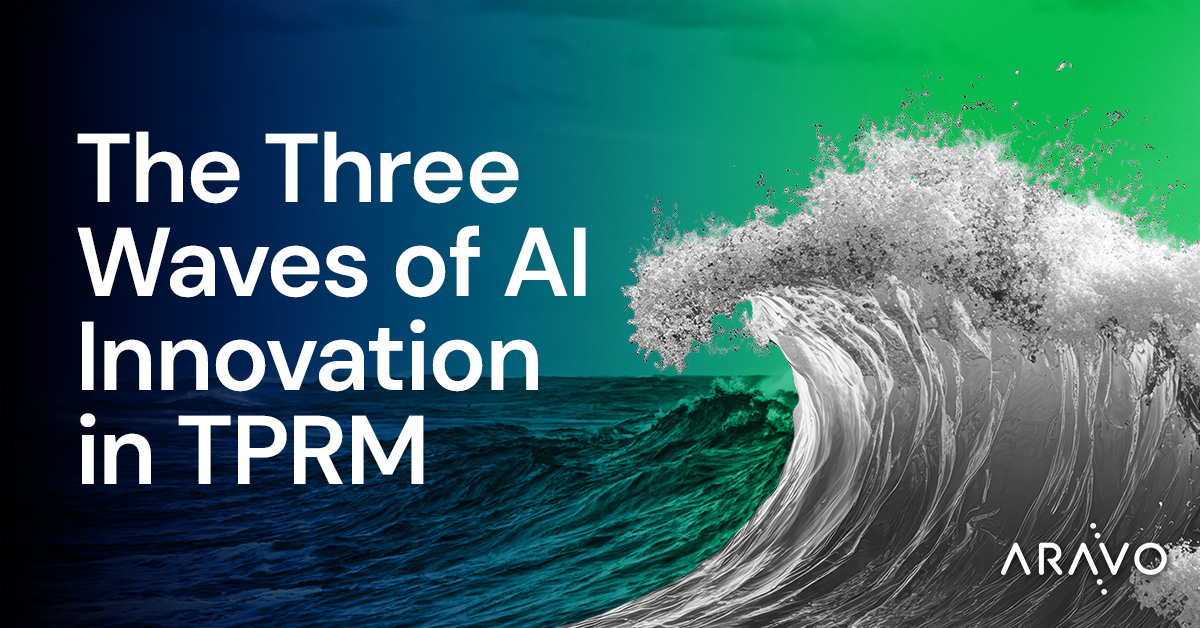
We’ve been talking a lot about how Third-Party Risk Management (TPRM) is at a turning point, poised for a significant transformation through the next wave of AI innovation. At the TPRA 2025 Conference, Dean Alms, our Chief Product Officer, and I shared Aravo’s vision for the future of TPRM, emphasizing how AI is set to redefine the discipline. The response we received from attendees and fellow TPRM professionals made us realize we were on to something: if AI technology is here to stay – and we believe it is – it’s critical that organizations understand and consider its varying levels of impact if they are to leverage it to strengthen and streamline their TPRM programs.
That got us thinking: what better way to amplify the conversation – and spark a productive dialogue – than to share our insights with our greater TPRM community? Read our high-level overview below outlining the primary degrees of AI in third-party risk management, which Dean unpacked even further during an engaging (and entertaining!) AI Innovation Session at this year’s Gartner Security & Risk Management Summit.
When thinking about how artificial intelligence is shaping the future of TPRM, it’s helpful to picture AI’s impact as three primary waves (and as we head into another heat-intensive summer, it’s no wonder this theme hits especially well). Each wave builds upon the last, gaining momentum as it moves from automation to interactive assistance and ultimately, to autonomous risk management. These layers of technological enhancements facilitate a rush of benefits: increased efficiency, improved accuracy, and greater scalability.
This initial wave focuses on using machine learning to analyze historical data and improve decision-making. Use cases include automating third-party approvals, segmenting third parties based on criticality, and reducing false positives in news event monitoring. Think of third-party approval cycles — AI can provide pattern-based recommendations with a high degree of confidence, greatly accelerating vendor intake and scoping, not to mention due diligence and contracting processes. This frees up TPRM professionals for more strategic work.
The second wave introduces what are called, “AI agents” – autonomous software systems or entities designed to perform tasks, pursue goals, and make decisions on behalf of users or other systems, often with little or no human intervention, simplifying interactions with generative AI. These agents can be customized for specific tasks, such as corporate identity capture, inherent risk calculation, compliance Q&A, and document parsing, making AI risk management faster and more accessible.
The third wave leverages Agentic AI to create orchestration platforms that can autonomously make decisions and take actions. This advanced form of AI continually learns from interactions and minimizes the need for human intervention, streamlining complex TPRM workflows and improving overall accuracy. Key to this wave is ensuring the trustworthiness of data, which becomes paramount as AI drives more autonomous actions. Use cases include the development of intelligent vendor profiles and trust score optimization – both of which can serve as validation mechanisms to fuel self-governing supplier trust portals.
As we’ve demonstrated through our Intelligence First PlatformTM, Aravo is committed to leading the AI-driven transformation of TPRM. Our strategy involves a phased approach, moving from machine learning-driven decision models to GenAI-powered AI agents and ultimately to Agentic AI orchestration platforms. This roadmap is designed to deliver tangible value to TPRM programs, including optimized processes, improved risk management, and enhanced collaboration.
Let’s face it: innovation can be messy and unpredictable, often triggering conflicting feelings of FOMO (Fear of Missing Out) versus FOMI (Fear of Messing It Up – a phrase Dean coined and one that might very well find its way to the Gen Z social arena). However, adoption can actually be predicted based on varying levels of risk appetite, which is why we encourage organizations to embrace the transformative power of AI today to achieve faster, better, and cheaper TPRM tomorrow.
By strategically leveraging AI with a phased approach – assessing current maturity, aligning with risk tolerance, and developing an AI roadmap – organizations can mature their TPRM programs from chaotic and fragmented to orchestrated and integrated, staying ahead of risk and regulations, improving stakeholder perception, and achieving critical business objectives.
Continue the conversation by joining our live webinar this August: “The Next Wave of AI Innovation in TPRM.” We’ll go beyond the buzzwords to explore practical applications, emerging trends, and how AI can drive real value in your third-party risk program.
Register now to save your seat and be part of the discussion shaping the future of risk management.
To dive even deeper into the conversation – and learn more about these three distinct waves – reach out to speak with one of our TPRM experts.
Share with Your Friends: